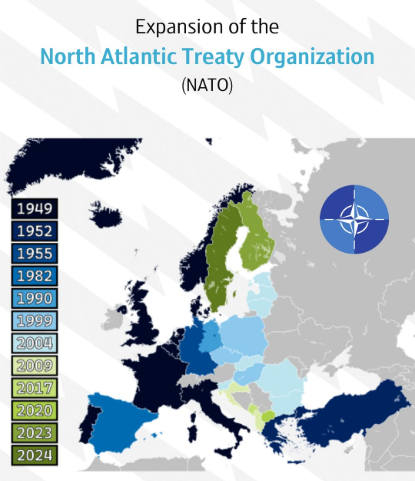NATO Expansion over Time Map


Marcus Rodriguez
Historical Geography Expert
Marcus Rodriguez specializes in historical cartography and geographic data analysis. With a background in both history and geography, he brings unique...
Geographic Analysis
What This Map Shows
This map provides a visual representation of the expansion of the North Atlantic Treaty Organization (NATO) over time, highlighting the countries that have joined the alliance since its inception in 1949. The map distinctly illustrates the timeline of NATO's growth, showcasing how it has evolved from its original 12 member countries to the current configuration that includes 31 countries as of 2023. With Canada and the USA as founding and pivotal members, the map also emphasizes their strategic roles in shaping NATO's direction and policies.
Deep Dive into NATO Expansion
NATO, established in 1949, was initially formed as a collective defense mechanism against the Soviet threat during the Cold War. The alliance was built on the principle that an attack against one member is an attack against all, which forms the bedrock of its mutual defense clause, Article 5. The early years of NATO were characterized by a static membership, primarily comprising Western European nations along with North American allies, Canada and the USA.
However, as the geopolitical landscape shifted with the end of the Cold War in the late 20th century, NATO's expansion began to accelerate. The first wave of new members, including countries from Central and Eastern Europe, joined in the late 1990s. Notably, Poland, Hungary, and the Czech Republic became part of NATO in 1999, marking a significant shift in the alliance's reach toward the borders of Russia.
What's fascinating is that NATO's expansion is often viewed through the lens of security and stability. By incorporating former Soviet bloc countries, NATO aimed to provide a security umbrella that would prevent conflicts and promote democratic governance in those regions. This is particularly evident with the accession of the Baltic states—Estonia, Latvia, and Lithuania—in 2004. Their inclusion not only solidified NATO's presence in the region but also served as a counterbalance to Russian influence.
Interestingly, the 2004 enlargement also introduced a new dynamic regarding NATO's relationship with Russia, which perceived the alliance's eastward march as a direct threat to its sphere of influence. This tension has since been a backdrop to NATO's ongoing operations and strategic decisions.
As of 2023, NATO’s latest expansion includes Finland and Sweden, reflecting a significant shift in security policy in Northern Europe due to rising security concerns from Russia. Finland, sharing an extensive border with Russia, made a historical decision to join NATO, a move that speaks to the evolving nature of international alliances in the face of contemporary threats.
Regional Analysis
Examining the map reveals notable differences in NATO membership by region. In Western Europe, the original members have maintained significant military cooperation and interoperability, contributing to a robust defense posture. However, newer members in Eastern Europe often face a different reality, marked by historical tensions and varying capabilities.
For instance, while countries like Poland and the Czech Republic have made substantial investments in their military infrastructure, others, such as Montenegro and North Macedonia, are still developing their defense capabilities. The disparity in military readiness across member states underscores the complexities of NATO’s collective defense strategy, especially in light of recent tensions in Eastern Europe.
Furthermore, the inclusion of Canada and the USA as foundational members has had a profound impact on NATO's global strategy. Their military resources and nuclear capabilities significantly bolster NATO's collective defense, creating a strong deterrent against potential aggressors. The USA, in particular, has been pivotal in leading NATO operations, from peacekeeping missions to counter-terrorism efforts.
Significance and Impact
The ongoing expansion of NATO has far-reaching implications for global security and international relations. It reflects a shift in geopolitical dynamics, where countries seek alliances to bolster their security and influence in an increasingly multipolar world. The map not only illustrates historical expansion but also highlights contemporary issues such as the rise of nationalism and the reassertion of great power competition.
As the geopolitical landscape continues to evolve, the future of NATO remains a topic of considerable debate. Will there be further expansions? How will NATO adapt to emerging threats like cyber warfare and hybrid conflicts? These questions will shape the alliance's strategic direction in the coming years. The NATO expansion map serves as a crucial tool for understanding these dynamics and the intricate relationships between member states and global powers.
In conclusion, NATO's expansion is more than just a historical timeline; it is a reflection of changing security paradigms and the ongoing quest for stability in an unpredictable world. The implications of this growth are profound, influencing diplomatic relations, military strategies, and the collective security of its member nations.
Visualization Details
- Published
- August 13, 2025
- Views
- 252
Comments
Loading comments...